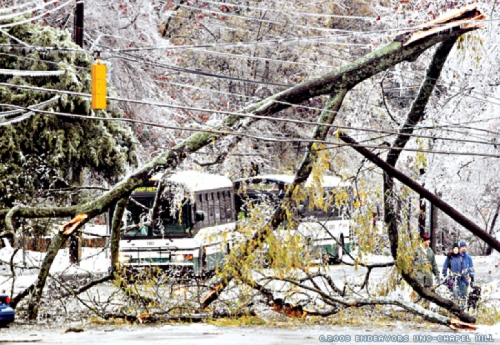Ice storms are no stranger to Tar Heel residents, but the glaze that encased our state the first week of December 2002 was a doozy. Residents in a wide swath from Charlotte to Kerr Lake will long remember the night of December 4-5 for its surreal din — the repeated pop-swoosh of tree limbs crashing outside bedroom windows, the buzz and flash of power lines snapping under the weight of ice and fallen branches.
About 1.7 million North Carolinians rose in the morning to find their homes cold and dark, and power outages persisted as long as ten days in some locations.
Even as the state cleared storm debris and tallied official losses (nearly $100 million as of January 9), a new report by Carolina’s Odum Institute and RTI International detailed not only the extent of service interruptions but some of the more easily overlooked costs of the storm. In December, researchers telephoned 457 households in thirty-six disaster-area counties of the state and asked how they had fared. Seventy-one percent of full- and part-time workers reported having missed work, typically at least one full day. Seventy-eight percent reported losing power at home, which led to further costs: 28 percent said they spent nights away from home, and half of households without power lost food to spoilage. Fourteen percent reported property damage, with a $400 median cost estimate for repairs.
The survey was undertaken to collect often-neglected data on the costs of disaster and the coping strategies of victims. “People are very resourceful,” says Kenneth Bollen, director of the Odum Institute. “While four of five households lost power and 58 percent lost heating, two-thirds had alternative ways to heat at least some part of their household.” Still, 38 percent of households that lost power had no alternative heating source.
North Carolina is heavily forested and susceptible to wind and ice storms that pelt above-ground power lines with falling branches. Every outage brings renewed calls for the burying of power lines. Yet, the cost of that upgrade — about $1,000 per customer if financed all at once — exceeds people’s willingness to pay. In fact, only 47 percent of respondents indicated they would consent to any payment toward burying lines, and fully half of those willing to pay placed a limit on their outlay at $5 per month. Interestingly, respondents did register approval in surprising numbers (80 percent) for the sometimes controversial practice of trimming trees near power lines.
Bollen is pleased the governor’s Natural Disaster Preparedness Task Force cited data from the study in its January 31 post-storm report. Since North Carolinians must count power outages a perennial and permanent threat, Bollen hopes the survey can give state officials insight into the hidden costs of natural disasters and how better to educate the public, so that future outages might take a lesser toll.
Willam C. Nelson was formerly a staff contributor for Endeavors.


